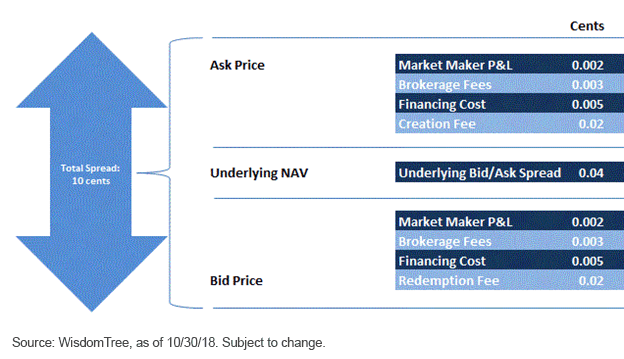NAV Doesn’t Mean Free: ETFs Vs. Mutual Funds
ETFs and mutual funds get compared constantly, and we have covered the topic numerous times in the past. Today we zoom in on one key difference between ETFs and mutual funds: how transactions are executed. Investors of mutual funds like the fact that the funds transact at net asset value (NAV), because they think they’re not paying the spread seen on-screen for ETFs. In fact, mutual funds, just like ETFs, are wrappers around baskets of securities. And just because a mutual fund transaction occurred at NAV, does not mean it was FREE! In fact, based on a broad study of 3,799 mutual funds from 1995 to 2006, it’s estimated that the funds’ aggregate trading costs were 144 basis point (bps) a year, on top of the expense ratios.1
The main difference between ETFs and mutual funds is that ETFs are traded on an exchange and, as a result, the spread cost is fully transparent. Mutual fund holdings are not transparent, and nor are the costs baked into the NAV. With ETFs, investors know the exact cost to enter and exit their position, as illustrated by the spread seen on the exchange. Figure 1 deconstructs a basic ETF spread, using the WisdomTree U.S. MidCap Earnings Fund (EZM) from October 2018 as an example.
Figure 1: Building Blocks of a Basic ETF Spread—EZM

As you can see in Figure 1. the full cost spread of 10 cents in EZM consists of the spread of every underlying stock in the basket, transaction costs and a small fee for the market maker’s service. This spread defines what is known in the ETF industry as the “arbitrage band,” or the cost a market maker would incur to transact in the underlying portfolio. In contrast, if an investor purchased a mutual fund with the same underlying portfolio as EZM, he or she would send their money to the mutual fund company and receive NAV in return. But what determines a mutual fund’s NAV? Besides the value of the holdings, a mutual fund’s NAV is reduced by the same kinds of costs that investors see in the real-time bid/offer spreads of ETFs. The spread or costs for a mutual fund may not be visible, but that doesn’t mean they don’t exist.
Additional Liquidity Benefit:
An added bonus of the ETF structure can come into play once an ETF reaches critical mass and begins to trade more frequently. The ETF can trade inside its arbitrage band, which is less than the cost to transact in the underlying portfolio. Natural buyers and sellers meet on an exchange and trades are paired with no need for transactions in the underlying portfolio. The net benefit to investors once an ETF reaches this level of liquidity is a savings in transaction costs, from not trading in the underlying market. Figure 2 shows EZM trading at a 2-cent bid/ask spread and proves the ETF can trade below its 10-cent arbitrage band. Mutual funds never have this opportunity, as the portfolio manager always needs to buy or sell assets when money comes into or out of the fund. Trading in the mutual fund will cause it to incur costs that are very similar to those seen in the ETF spread example in figure 1, and each transaction will erode the mutual fund’s NAV.
Figure 2: Spread Snapshot Inside Arbitrage Band—WisdomTree U.S. MidCap Earnings Fund (EZM)

Mutual Fund Trading Costs Impact All Holders
The final key difference when it comes to trading costs for ETFs compared to mutual funds is that every transaction cost in an ETF is independent and borne by the investor making that transaction. The creation/redemption process in ETFs allows for shares of the underlying portfolio to be transferred in-kindin exchange for ETF shares by a middle man, known as an authorized participant (AP). This means that transactions in the underlying portfolio are executed by liquidity providers, outside of the ETF portfolio, and those costs are baked into each investor’s execution (spread). In a mutual fund, however, all trading of the underlying securities occurs inside the portfolio and every trade cost is shared by all investors regardless of their percentage ownership in the fund.
The bottom line is that ETFs are built on a backbone of transparency, while mutual funds are opaque in nature. The next time you look at ETF spreads, remember what makes up the spread and that only the transacting investor bears the cost. Mutual funds may trade at NAV, but do not be mistaken—execution is not free!
1Roger Edelen, Richard Evans, and Gregory Kadlec, “Shedding Light on ‘Invisible’ Costs: Trading Costs and Mutual Fund Performance,” Financial Analysts Journal, 1/1/13.
Disclaimer: Investors should carefully consider the investment objectives, risks, charges and expenses of the Funds before investing. U.S. investors only: To obtain a prospectus containing this ...
more










